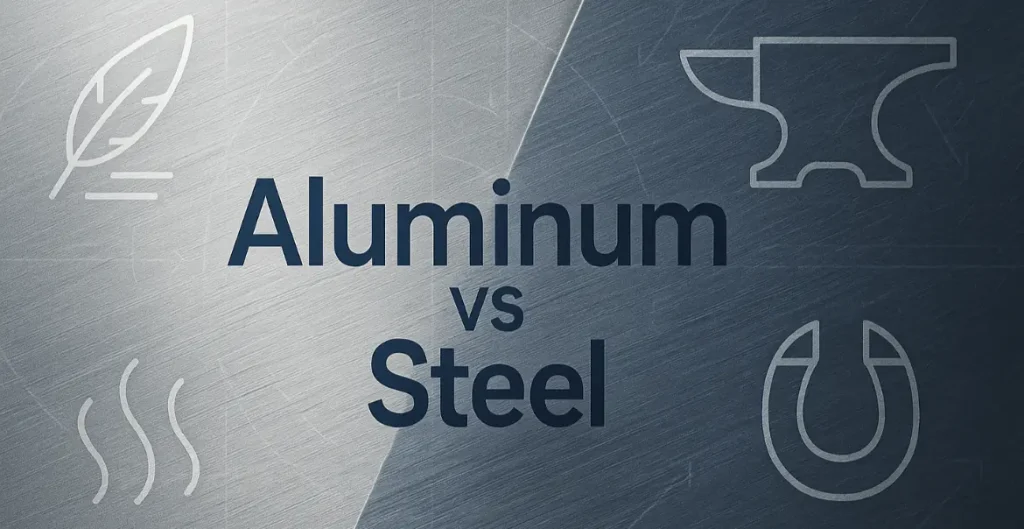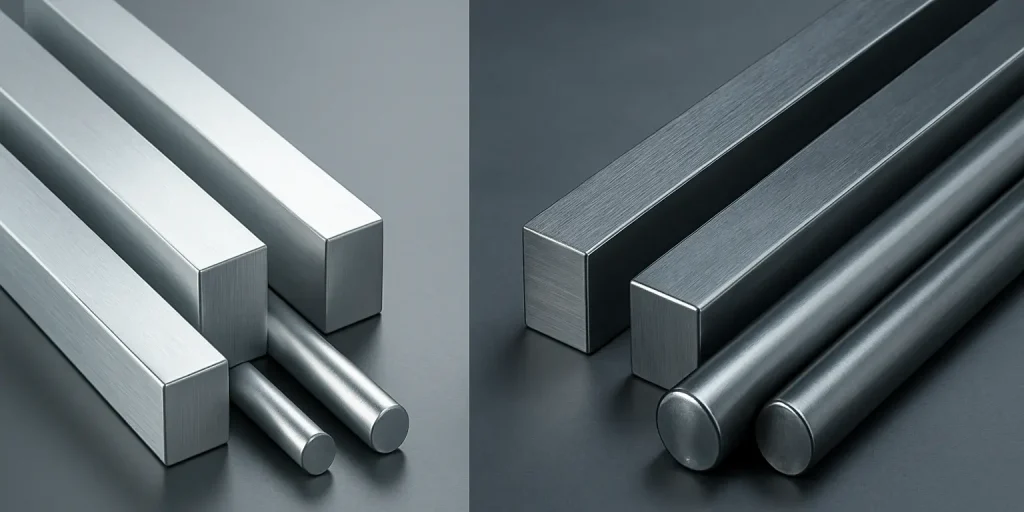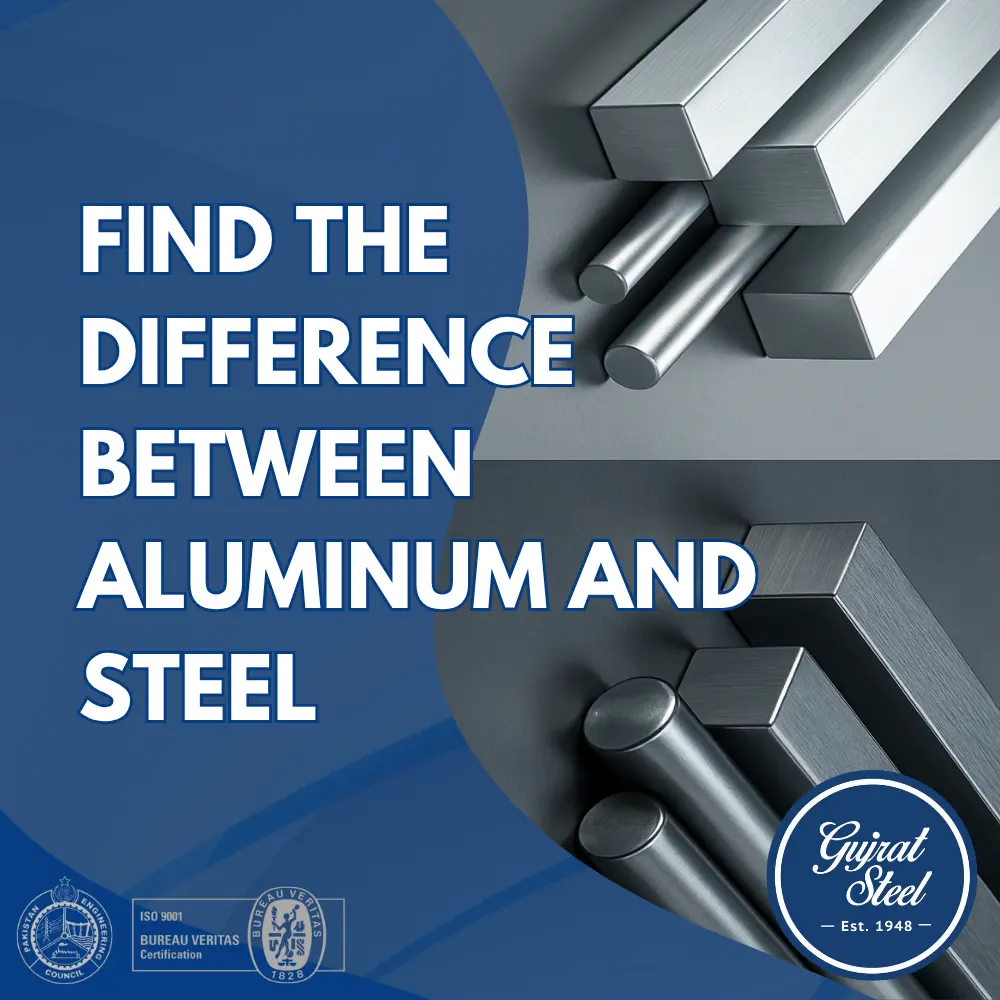Aluminum is a lightweight, corrosion-resistant, and conductive metal with an excellent strength-to-weight ratio. Steel is denser, stronger, and cheaper but prone to rust unless treated. The choice depends on whether weight, strength, or cost is the priority for a specific application.
Key Takeaways:
- Strength vs. Weight: Steel is stronger and denser. Aluminum has a superior strength-to-weight ratio, making it ideal for lightweight applications.
- Corrosion: Aluminum naturally resists corrosion by forming a protective oxide layer. Most steel rusts easily and requires coating or alloying.
- Cost: Steel is generally cheaper per pound. Aluminum’s higher production cost is sometimes offset by lower maintenance and transportation expenses.
- Workability & Conductivity: Aluminum is easier to form and is an excellent thermal and electrical conductor, whereas steel is more difficult to work with and a poor conductor.
Table of Contents
Introduction
Aluminum and steel stand as two of the most widely used metals in modern industry, each possessing a unique set of properties that make them ideal for a vast array of applications. While often used interchangeably in some contexts, their fundamental differences in strength, weight, cost, and durability make the choice between them a critical design and engineering decision.
At a Glance: Key Differences
| Property | Aluminum | Steel |
| Density | Low (approx. 2.7 g/cm³) | High (approx. 7.85 g/cm³) |
| Strength | Generally lower | Generally higher |
| Strength-to-Weight Ratio | Excellent | Good |
| Cost | Generally more expensive per pound | Generally less expensive per pound |
| Corrosion Resistance | Excellent (forms a natural protective oxide layer) | Prone to rust (requires coating or alloying) |
| Conductivity | Excellent thermal and electrical conductor | Poor thermal and electrical conductor |
| Workability | Easier to machine and form | More difficult to work with |
| Melting Point | Lower (approx. 660°C) | Higher (approx. 1370°C) |

Strength and Weight: A Balancing Act
One of the most significant distinctions between aluminum and steel lies in their strength-to-weight ratio.
Steel is inherently stronger and denser than aluminum. This makes it the go-to material for applications where pure strength and durability are paramount. Think of the structural skeletons of skyscrapers, bridges, and heavy machinery. The high carbon content in most steel alloys contributes to its hardness and ability to withstand immense stress.
Aluminum, on the other hand, boasts an exceptional strength-to-weight ratio. While not as strong as steel in a direct comparison, its significantly lower density means that for a given weight, an aluminum structure can be thicker and often stronger than a steel counterpart. This is a critical advantage in industries like aerospace and automotive, where reducing weight is crucial for fuel efficiency and performance. An aircraft fuselage or a high-performance sports car chassis benefits immensely from aluminum’s lightweight yet robust nature.
Cost and Environmental Considerations
The initial cost of steel is generally lower than that of aluminum on a per-pound basis. This is largely due to the abundance of iron ore and the well-established, large-scale production methods for steel.
Aluminum production, in contrast, is an energy-intensive process, primarily involving the electrolysis of alumina extracted from bauxite ore. This higher energy consumption translates to a higher initial material cost. However, the lifecycle cost of an aluminum product can sometimes be lower due to its corrosion resistance (reducing maintenance costs) and its lighter weight (leading to fuel savings in transportation applications).
Both metals are highly recyclable, which is a significant environmental advantage. Recycling aluminum is particularly energy-efficient, requiring only a fraction of the energy needed for primary production.
Corrosion Resistance: The Natural Armor
Here, aluminum has a distinct natural advantage. When exposed to air, aluminum rapidly forms a thin, tough, and transparent layer of aluminum oxide on its surface. This layer acts as a natural barrier, protecting the underlying metal from further oxidation and corrosion. This makes aluminum an excellent choice for outdoor applications and in environments where moisture is a concern, such as in marine components and building facades.
Most common forms of steel, on the other hand, are susceptible to rust (iron oxide) when exposed to oxygen and moisture. To combat this, steel often requires protective coatings such as paint, galvanization (a zinc coating), or alloying with other elements like chromium and nickel to create stainless steel, which offers significantly improved corrosion resistance but at a higher cost.

Conductivity and Workability
Aluminum is an excellent conductor of both heat and electricity. This property makes it ideal for applications such as heat sinks in electronic devices, electrical power lines, and high-quality cookware.
Steel, in contrast, is a relatively poor conductor of heat and electricity. This can be an advantage in situations where heat transfer needs to be minimized.
In terms of workability, aluminum is generally easier to machine, cut, and form than steel. Its lower hardness and melting point mean that it requires less force and energy to shape, which can lead to faster and more cost-effective manufacturing processes. Steel’s hardness and high melting point make it more challenging to work with, often requiring more robust machinery and specialized techniques.
Welding and Fabrication
Welding steel is a well-understood and relatively straightforward process. Its higher melting point and lower thermal conductivity make it more forgiving during welding.
Welding aluminum presents more of a challenge. Its high thermal conductivity can dissipate heat quickly from the weld zone, and the presence of the protective oxide layer (which has a much higher melting point than the aluminum itself) requires special cleaning and welding techniques, such as TIG or MIG welding.
Applications: Where They Shine
The distinct properties of aluminum and steel dictate their primary uses across various industries:
Aluminum is favored for:
- Aerospace: Aircraft frames, wings, and other components where weight is critical.
- Automotive: Body panels, engine blocks, and wheels to improve fuel economy.
- Construction: Window frames, curtain walls, and roofing due to its corrosion resistance and light weight.
- Electronics: Heat sinks, and chassis for its thermal conductivity and non-magnetic properties.
- Packaging: Beverage cans and foil due to its formability and barrier properties.
Steel is the material of choice for:
- Construction: Structural beams, rebar, and infrastructure where high strength is essential.
- Heavy Machinery: Frames and components for industrial and agricultural equipment that endure high stress.
- Automotive: Chassis and safety cages for its strength and impact resistance.
- Pipelines: For transporting oil, gas, and water due to its strength and durability.
- Tools and Appliances: For its hardness and wear resistance.



